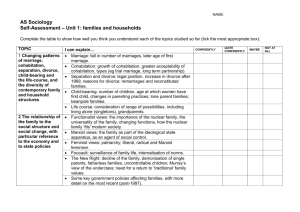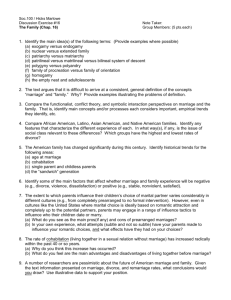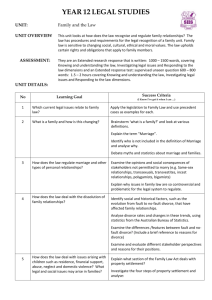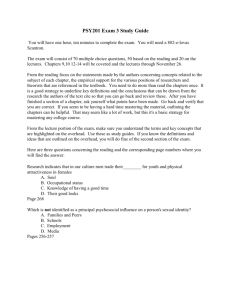File - Yesenia King
advertisement
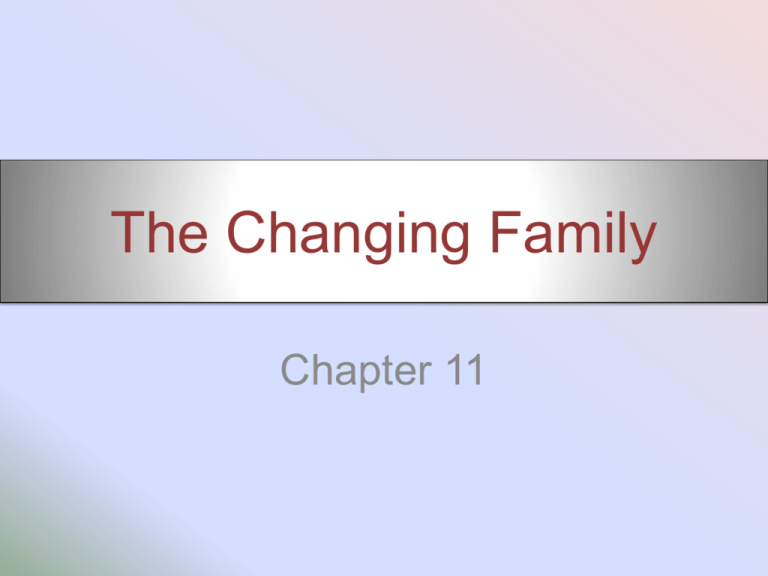
The Changing Family Chapter 11 Marriage and Family Defined • Family - a group of people related by marriage, blood, or adoption. – social institution that unites individuals in cooperative groups that care for members, regulate sexual relationships, and oversee the bearing and raising of children • Functionalist perspective • Most important social institution – Enduring features of social life • Stresses how family is related to other parts of society and how it contributes to the well-being of society The Problem in Sociological Perspective • Effects of the Industrial Revolution on the family Men left home Children became an economic liability Formal education A lower birthrate From rural to urban Loss of functions Changes in women’s roles The Scope of the Problem • Modernity Social and cultural factors relating to recent times or the present So powerful, family isn’t going to be able to adjust • Divorce Increased steadily since 1970 • Is divorce a sign of weakness or strength? Can interpret divorce statistics in many ways • The children of divorce Involves other things that cannot be quantified Cohabitation Family Types • Nuclear family – wife, father, and children • Extended family – nuclear family plus other relatives – like grandparents, cousins, aunts, uncles, etc. • Marriage - a legal union based on mutual rights and obligations – Marriage = wedding - culture Mate Selection • Romantic Love – idea of people being sexually attracted to one another and idealizing the other – Ex. Soul mate – 2 components: 1) Emotional – feeling of sexual attraction 2) Cognitive – feeling we describe as being “in love” • Homogamy –the tendency to marry someone similar to oneself based on personal preference. • Heterogamy – partners are dissimilar with respect to some important social characteristics. – Interracial marriage New Family Forms • Marriage rate – the number of marriages per year for every one thousand members of a population. – The U.S. marriage rate has fluctuated since 1940. Median Age at First Marriage FIGURE 11.1 SLIDE 3 – INSERT FIGURE 11.1 ON PAGE 340 OF TEXT Cohabitation • Cohabitation – living with someone in a marriagelike arrangement without the legal obligations and responsibilities of formal marriage. – While cohabitation is more common among people with less education, it is increasing at higher educational levels. – Cohabitation is on the rise. In 2009, cohabitation increased by 13 percent, twice the average annual increase of the preceding few years. – Cohabitation has almost doubled since 1990. Single-Parent Families • have been on the rise since 1970; 23 million children now live in single-parent families (32 percent of all children); 6 times higher than 1940, 3 times higher than 1970, and about double what it was in 1980 • 95% of children in single-parent families are in singlemother families • Children in single-parent families are without the same economic resources available in two-parent families. • Most research indicates that growing up with a single parent negatively affects a child’s well-being. Single-Parent Families – Economic Outcomes • Children in single-parent homes: – – – – – exhibit more behavioral problems, have higher teenage pregnancy rates, perform lower academically, score lower on tests of psychological well-being, are less able to adapt in social settings than children living with their biological parents Childless Marriages • In the past, there was a stigma attached to marriages without children. • In 2008, one in five American women ages 40–44 was childless, up 80 percent since 1970 – Highest rates among White women, highly educated women. • Reasons to remain childless: – – – – – – less stigma importance of careers Independence do not enjoy children too much delay physical or mental limitations. Same-Sex Domestic Partners • Due to the stigma surrounding homosexuality, it is difficult to know exactly what proportion of the American population is gay. • Americans have differing views of legalizing same-sex marriage: – 48% of Americans oppose legalizing gay marriage; 42% favor it. • Same-sex partners living together with children—are also increasing in number, although their number is small compared with heterosexual marriages. Adult Children Returning Home • “Boomerang kids” – – young adults (18-34) have a much higher probability of living in their parents’ home than they did 30 years ago. • Contributing factors: – Young adults are marrying later. – More young adults are continuing their education, and live at home while doing so. – Due to the high cost of living, young adults return home after completing their education. – High divorce rate also increases the proportion of young adults living at home. Adult Children Returning Home: Consequences • An added financial burden for older parents. • Many parents complain that their adult children do not share in expenses, fail to help around the house, invade privacy, and prevent them from developing relationships with spouses and friends. • Adult children living at home forfeit some freedom and are subject to some unwanted parental control. The Sandwich Generation • More middle-aged adults are finding mothers and fathers living with them. • Sandwich generation – term applied to those adults caught between caring for their parents and caring for the family they formed after leaving home. – Elderly parents receive better care from those who love them and feel responsible for them. – Aging parents also offer emotional support and financial resources. – Taking care of an elderly parent is not easy, physically or emotionally. – The burden of caring for an aging parent falls much more heavily on women. – About 2/3 of unpaid caregivers are female. Divorce • Divorce rate – the number of divorces annually for every thousand members of the population. • The nagging dilemma of divorce – Decision to divorce is usually painful, preceded by years of dissatisfaction and unhappiness • Research – people who go to college, belong to a religion, wait to get married, and have children have a much better chance of their marriage lasting. • Working with co workers of opposite sex and working with people who are recently divorced, increase one’s risk of divorce • Divorce and children Family Violence • Over 1/5 of all reported cases of aggravated assault involve domestic violence, however many episodes go unreported. • Domestic violence involves children, spouses, siblings, and older people. • As many as ½ of married women in the U.S. are victims of spousal violence. • At least 4 million women are battered by their husbands annually. • 4,000 women each year are beaten to death. • 14% of married women are sexually attacked by their husbands every year. • ¾ of spousal violence occurs during separation or after divorce. Family Violence • Alcohol and violence – The more people drink, the more likely they are to beat their spouse. • The social heredity of violence – Children learn from their parents that violence is a way to solve problems. Family Resiliency • Family resiliency – refers to the family’s capacity to emerge from crises as stronger and more resourceful. • Families that flourish despite distress are resilient. • Family friendly policy Functionalist Theory of Families - Stresses how family is related to other parts of society and how it contributes to the well-being of society Functions of the Family – Economic production, socialization of children, care of sick and aged, recreation, sexual control, and reproduction. Conflict Theory and Family • Draws attention to the struggles of scarce resources: – Housework = time, energy, leisure – “second shift” • False consciousness Failure to recognize the state of one’s exploitation • Power and the marital experience Today’s women are less dependent on mates. • Conflict theorists stress that marriage and family patterns reflect historical struggles between men and women. • Examines women’s oppression and how the family has been used to maintain male domination of females. – The family perpetuates gender inequality Symbolic Interaction and Family • An overloaded institution Symbolic interactionists examine what people expect out of marriage • The love symbol: engulfment into unrealistic expectations – Optional emotions have now become mandatory emotions • • • • Changing Ideas about Divorce Changing ideas about children Changing expectations of parenting Changing marital roles Society used to expect the husband to assume the role of breadwinner – How each sex experiences marriage differently • Ex. housework • Relationships within the family are constantly being redefined. Conservatives: Traditional Family Values • The family as the core of a society • Source of problems stem from a break with traditional families – Rising divorce and cohabitation; gay marriage – “Me” generation • Solution would be to go back to traditional family values Liberals: Many Kinds of Families • Support variability in family form • Poverty and domestic abuse are the biggest problems • Increase support to families – Child Care • Higher minimum wage • Pay women as much as men Radicals: Replace the Family • Family is related to inequality • Family is how property is passed on from one generation to the next • Family is related to perpetuating inequality • Perpetuates inequality based on sexual orientation Looking Forward • Is the nuclear family deteriorating? – Family Decline Perspective – Family Change Perspective • The nuclear family remains the most popular choice among Americans. The Future of the Problem • Rapid social change as normative Change is so rapid and extensive that parents and children live in different worlds. • Changes we can expect Age at first marriage will continue upward Cohabitation will continue to increase Marriage will become even more oriented around companionship Divorce rate may decline • The ideological struggle
